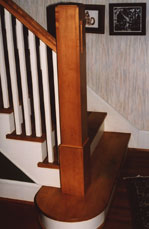 Building
a balustrade
Building
a balustradeBy Ross Collins
Next time you’re walking upstairs in an old house—maybe your own—take a closer look at the newel post. That’s the big wooden post attached to the bottom of the stairway. The handrail attaches to the newel post at the bottom, and either to another newel at the top, or to a half-newel built into the wall. What we usually call spindles, but are properly called balusters, fall from the handrail to the steps, properly called treads, either directly, or into a skirtboard extending from the side of the stairs. Together the whole rail assembly is properly called a balustrade.
Handrails may run post-to-post, or to the delight of youngsters who like to slide, rail-over-post. Rail-over-post is thought to be more elegant, but is harder to build, and requires a sturdy newel post indeed. The decorative flourish at the end of some rails is property called a volute. Box newels (the square kind) lend themselves more often to the post-to-post style, while turned newels often support rail-over-post style. Some handrails include curved pieces reaching to posts, called goosenecks and easements. Hitting a sharp easement at the end of a long slide may help persuade aging pranksters they are getting too old to try this kind of sturdiness test.
Most handrails and volutes are manufactured off-site in millwork companies, and have been since at least the beginning of the century. Curtis Lumber and Millwork Co. of Pittsburgh offered an extensive hardbound catalogue to early 20th century home-builders, and likely the original stair parts installed in many Midwestern homes shipped from there.
Stylish treads often included a bullnose step at the beginning, that is, a curved tread end extending around and back to the staircase skirtboard. Bullnose tread assemblies can be pre-manufactured, or constructed on site using a band saw. They are attached to a bullnose riser, the term used for vertical pieces of a step. A bullnose riser can be cleverly built on site: a craftsman working on a table or radial arm saw slices a series of crosscuts across a board, leaving only a thin sliver of wood, bends the cuts to a curved form, and glues the whole assembly. Done correctly, the cuts won’t show. Oak bends more easily, as I discovered trying to do this using Number One Common dimensional pine from a big-box lumberyard. Luckily, our fireplace works fine.
Newel posts sometimes are bolted only to the tread, although that’s usually a recipe for a shaky balustrade. Better is to bolt it to the stair horse, part of the assembly that supports the treads. Most conscientious finish carpenters run a threaded rod through the entire post, through the tread, through the floor, and into a heavy bracket bolted to a joist from the basement. Keep this in mind should you think it easy to remove your newel post for refinishing.
Perhaps carpenters have a particular vocabulary covering stair-building because it’s such a specialized skill. Traditionally only the finest craftsmen emerged from the building team to tackle the staircase, and then only after the framers and lesser finish carpenters wrapped up their work. In fact, a stair stood as pinnacle of a carpenter’s pride, a masterpiece worthy of a signature.
That’s why you’ll want to look into your newel post. Finish carpenters proud of a balustrade sometimes signed their names to a scrap of paper and dropped it into the newel post. Later workers removing the cap to tighten the post would discover the signature and—one hoped—marvel at the workmanship of this most difficult aspect of house-building.
Not such a craftsman, but craftily trying to save money, I recently rebuilt the stairway of our 1916 Arts and Crafts-style home. A previous owner had removed the entire balustrade, chopped off the decorative tread nosings (overhangs), lopped off the bullnose step, installed an outdoor-style wrought iron railing on flimsy slot-head screws, and slopped the entire monstrosity in paint. I hope such a fate has never befallen your staircase.
A balustrade rebuild doesn’t demand the kind of skill you need to put up the original. But it ain’t a one-weekend kiss-off, either. After a miserable month applying coat after coat of that orange-smelling paint stripper (you think we’re going to use the lye-based stuff in the middle of winter?), I laboriously scraped and sanded each tread. One and one-half hours per, one a day working evenings. With glee I dumped the handrail on the boulevard. (Some tasteless scavenger grabbed it during clean-up week. Oops. Hope it wasn’t you.)
I hadn’t planned to build my own box newel, but a local cabinet-maker I contacted apparently couldn’t see doing anything not in his standard contract book, so I was on my own. Bending the bullnose was, well, we already covered that. Most scary, though, was the handrail: I special-ordered a maple rail at $85. Cuts to make it fit needed to be at a precise angle of, um, 37 degrees or something, and a miscut could not be fixed. Believing I’d already added enough to my firewood pile, I agonized, re-measured, re-agonized, even cut a practice rail from two-by-four. Finally I took a deep breath and made the chop. Luckily, Crane-Johnson Lumber could get no more of my money. For handrails, anyway.
I give my final balustrade project a B: treads still look a bit rough, and newel post ended up one-fourth inch off center. But inside that newel post is a small slip of paper signed “Ross Collins, 2000.”